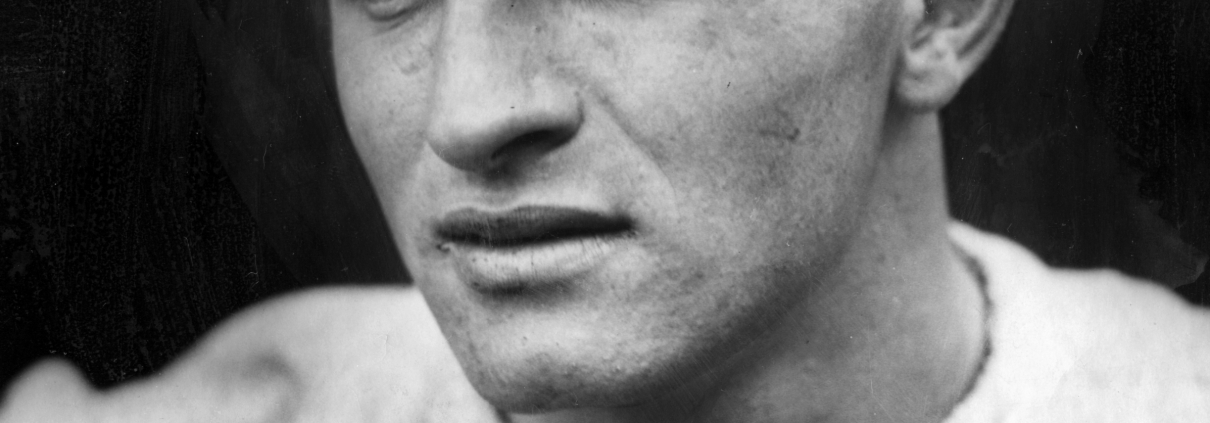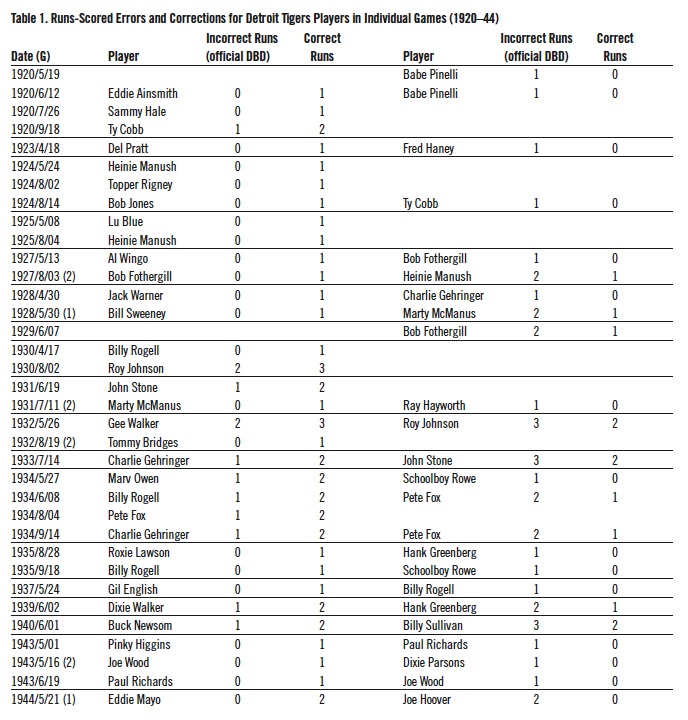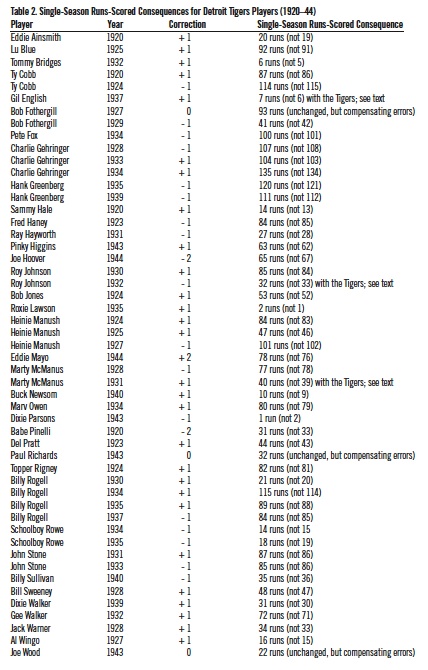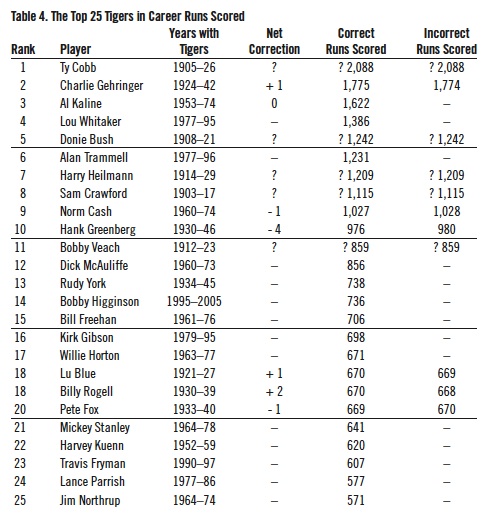The Authorized Correction of Errors in Runs Scored in the Official Records (1920–44) for Detroit Tigers Players
This article was written by Herm Krabbenhoft
This article was published in Spring 2011 Baseball Research Journal
The run is the most fundamental and the most important statistic in baseball. Regrettably, clerical (e.g., transcription) errors have been made in the process of crediting the runs scored by the individual players in MLB’s official records.[fn]Two possible sources for errors can enter the official records. The first possible source for errors in the official record is the transcription of the information on the official scorer’s scorecard to the “official score report” (sometimes referred to as the “official game report”). When the game is over, the official scorer is required to prepare a report of the game on a form prescribed by the league president. The official score report prepared by the official scorer includes (i) batting records (e.g., at bats, runs, hits, runs batted in, etc.) for each batter and runner, (ii) fielding records for each fielder, and (iii) pitching records for each pitcher. Significantly, in compiling the official score report, the official scorer is required to list each player’s name and fielding position(s) in the order in which the player batted – i.e., the batting order. The “batting records” portion of the official game report resembles the upper portion of the traditional box score, with columns for the various statistical categories. The second possible source for errors in the official record is the transcription (by a staffer in the league statistician’s office) of the information on the official game report to the official Day-By-Day (DBD) records, which are organized by player on a game-by-game basis. Finally, and critically, the following is stated in the Official Rules of Major League Baseball [Rule 10.01(a) Comment]: “In the event of any discrepancy in records maintained by a league statistician and the rulings by an official scorer, the report of such official scorer shall control.”[/fn] [fn]For the entire period of time covered in this article (i.e., 1920–44), the Howe News Bureau was the official statistician for the American League[/fn]
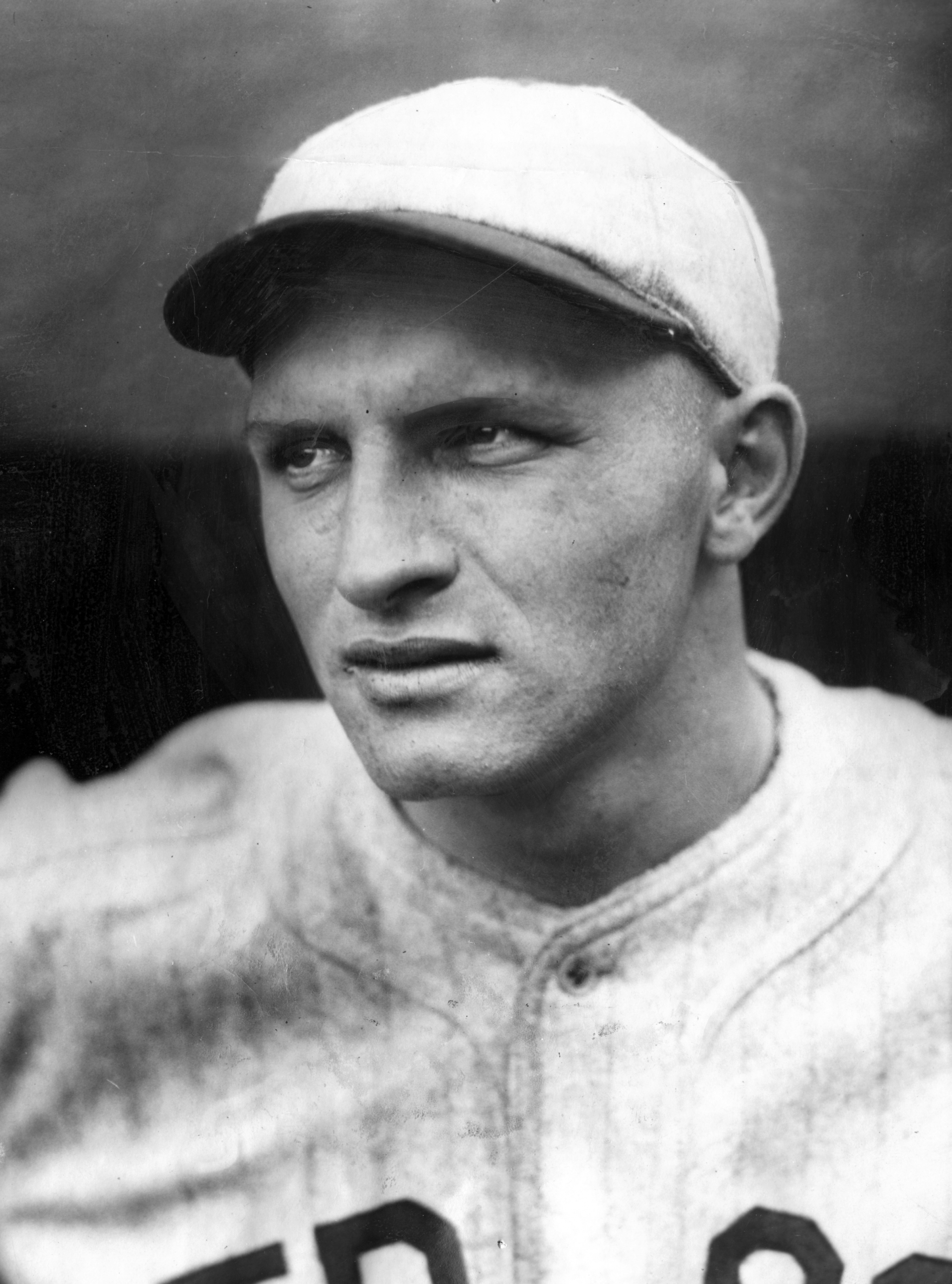 For example, according to the 1961 official American League records, New York Yankees Mickey Mantle and Bill Skowron scored 132 runs and 76 runs respectively. More than three decades later, however, tabulation errors in the records were discovered for the second game of the September 10 doubleheader between the New York Yankees and the Cleveland Indians. The official records indicated that Mantle scored two runs and that Skowron scored no runs in that game. In actuality, Mantle and Skowron each scored once in the game.[fn]Ron Rakowski, “*Another “Asterisk” for Roger Maris? Did Maris really lead the AL in RBI’s in 1961?,” Society for American Baseball Research convention (SABR 25), Pittsburgh, 17 June 1995. See also the “Retrosheet Newsletter,” Volume 2, July 1995, and the Baseball Records Committee newsletters, April 1995, and August 2010.[/fn] Therefore, for the entire season, Mantle actually scored 131 runs and Skowron actually scored 77. The requisite changes/corrections were subsequently made to the official records.
For example, according to the 1961 official American League records, New York Yankees Mickey Mantle and Bill Skowron scored 132 runs and 76 runs respectively. More than three decades later, however, tabulation errors in the records were discovered for the second game of the September 10 doubleheader between the New York Yankees and the Cleveland Indians. The official records indicated that Mantle scored two runs and that Skowron scored no runs in that game. In actuality, Mantle and Skowron each scored once in the game.[fn]Ron Rakowski, “*Another “Asterisk” for Roger Maris? Did Maris really lead the AL in RBI’s in 1961?,” Society for American Baseball Research convention (SABR 25), Pittsburgh, 17 June 1995. See also the “Retrosheet Newsletter,” Volume 2, July 1995, and the Baseball Records Committee newsletters, April 1995, and August 2010.[/fn] Therefore, for the entire season, Mantle actually scored 131 runs and Skowron actually scored 77. The requisite changes/corrections were subsequently made to the official records.
The consequences of correcting errors in the official Day-By-Day (DBD) records can be extremely significant. For example, correcting the Mantle-Skowron runs-scored mistake resulted in Mickey Mantle no longer being a co-leader in runs scored for the AL in 1961. Thus, before the error was corrected, it appeared that Mantle and Roger Maris tied for the AL (and major league) lead, each player having been officially credited with 132 runs. Following the correction, Maris was officially the sole leader in runs scored.[fn]Seymour Siwoff, The Elias Book of Baseball Records (New York: Elias Sports Bureau, 2010), 383.[/fn]
As can be clearly seen from the runs-scored errors for Mantle and Skowron, it is essential when carrying out research that relies on the actual numerical information provided in the official DBD records that the investigator first independently verify the accuracy of the statistics critical to his/her research objectives—i.e. identify and correct any errors in the official DBD records.
An area of particular interest to me concerns ascertaining the longest Consecutive Games Runs Scored (CGRUNS) streaks achieved by Detroit Tigers players. To properly conduct the research in order to accomplish my objective, it is mandatory to have accurate runs-scored information on a game-by-game basis for each Tigers player.
In this article I present results from my comprehensive investigation of the accuracy of the official baseball records for runs scored by Detroit Tigers players. As mentioned in a previous article, my research plan consisted of first dividing the hundred-plus years of Tigers history into manageable time periods: 1945–present, which I term Phase One; 1920–1944, which I call Phase Two; and 1901–1919, which I refer to as Phase Three. The results from Phase One were provided in a previous report.[fn]Herm Krabbenhoft, “The Authorized Correction of Errors in Runs Scored in the Official Records (1945–2008) for Detroit Tigers Players,” The Baseball Research Journal 37 (2008): 115.[/fn] This article presents the findings for Phase Two.[fn]Some of the results presented here were described in my presentation “The Longest Consecutive Games RUN Scored (CGRUNS) Streaks by Detroit Tigers Players (1920–44),” given at the annual meeting of the Baseball Records Committee at the Society for American Baseball Research convention (SABR 40), Atlanta, August 5–8, 2010.[/fn]
RESEARCH PROCEDURES
Here are the specifics of my modus operandi in obtaining reliable runs-scored information.
- Record the runs scored by each Detroit player in each Tigers game according to the box scores published in The New York Times.
- Generate DBD runs-scored lists from the runs-scored information extracted from the box scores in The New York Times for each Tigers player.
- Compare the newspaper box score-generated DBD information with the official DBD information to identify runs-scored discrepancies.
- Resolve the runs-scored discrepancies by examining the game accounts in three Detroit newspapers (The Detroit News, the Detroit Free Press, and the Detroit Times) and at least one newspaper from the city of the Tigers’ opponent, thereby ascertaining the exact batter-by-batter details for each run the Tigers scored.
- For the runs-scored discrepancies where the official DBD records are wrong, provide the supporting documentation to the Elias Sports Bureau (the official statisticians of Major League Baseball) for their review and approval.
With regard to assembling the supporting documentation needed to achieve the appropriate corrections of the runs-scored errors in the official DBD records, I adhered strictly to the guidance specified by Elias:
“We employ a standard of proof that lies somewhere between two of the standards common to judicial matters in this country: that is, somewhere between proof that is clear and convincing and proof that is beyond reasonable doubt.”[fn]R. Chamberlain, “SABR Nine Questions,” The SABR Bulletin, July–August, 2006, 6.[/fn] It is important to point out that, as discussed in my Phase One article, “If there is a run-scored error in both the newspaper boxscore and the official DBD record, the procedure I followed would not catch the error.”[fn]Herm Krabbenhoft, “The Authorized Correction of Errors in Runs Scored in the Official Records (1945–2008) for Detroit Tigers Players,” The Baseball Research Journal 37 (2008): 115[/fn]
RESULTS
Table 1 presents in chronological order the 57 runs-scored errors I discovered for the 1920–44 Detroit Tigers players. Thirty-seven players, including four subsequently elected to the National Baseball Hall of Fame, had runs-scored errors.
(Click image to enlarge.)
For each error I discovered, I also determined unequivocally the corrections, which I submitted to the Elias Sports Bureau. After careful review of the supporting documentation I provided to them, Elias sanctioned each of the changes/corrections proposed in Table 1.[fn]Personal communication (21 July 2010) with Steve Hirdt (Executive Vice President, Elias Sports Bureau). In a telephone conversation, Mr. Hirdt informed me that Elias has accepted the corrections to all of the runs-scored errors presented in Table 1.[/fn]
Inspection of the information provided in Table 1 reveals that for 22 of 35 games with runs-scored errors, two players were involved—one player undercredited with runs scored and another player overcredited. For example, the official DBD records for the April 18, 1923 game show Del Pratt with no runs scored, when he actually scored one run, and Fred Haney with one run scored, when in actuality he did not score.
In 13 of the 35 games with runs-scored errors, only one player was involved. This means that for each of those 13 games the sum of the runs scored by the Tigers players participating in the game did not equal the runs scored by the Tigers team. For 11 of those 13 games the official DBD records did not credit the player with all the runs he actually scored. For example, in the September 18, 1920 game, the official DBD records credit Ty Cobb with scoring one run. The Georgia Peach actually scored two runs in that game, in which the Tigers scored four runs. The uncorrected official DBD records show one run each for Claire, Cobb, and Veach and no runs for any of other Tigers player.
For two of those 13 games, the official DBD records credited the player with one more run than he actually tallied. On June 7, 1929, Bob Fothergill was credited with scoring twice when he actually scored only one of the team’s 17 runs scored.
The authorized corrections of these runs-scored errors in the individual games also have consequences in both the single-season and career records of the players. The next two sections deal with these consequences.
CONSEQUENCES – SINGLE SEASON
Table 2 presents the consequences of applying the single-game corrections (Table 1) to the final runs-scored totals for the specific seasons for each of the players, listed alphabetically.
(Click image to enlarge.)
As can be seen, most are one-run corrections; some are zero-run corrections (Fothergill in 1927, Paul Richards in 1943, and Joe Wood in 1943) as a result of compensating errors (i.e., plus one run in one game and minus one run in another game); some are two-run corrections (Joe Hoover in 1944, Eddie Mayo in 1944, and Babe Pinelli in 1920).
Some players had more than one season of runs-scored errors; Cobb, Fothergill, Greenberg, Roy Johnson, Marty McManus, Schoolboy Rowe, and John Stone each had runs-scored errors in two separate seasons. Charlie Gehringer and Heine Manush had runs-scored errors in three different seasons. Billy Rogell had runs-scored errors in four individual seasons.
All but three of the Table 2 players were full-season Detroit Tigers (Gil English in 1937, Roy Johnson in 1932, and Marty McManus in 1931). For these three, the single-season runs shown in Table 2 are for their time with only the Detroit Tigers.
A check of the various baseball record books and encyclopedias shows that only one Table 2 player led the league in runs scored: Charlie Gehringer in 1934. With the correction of Gehringer’s 1934 runs-scored error, his AL-leading runs-scored total is now 135 (not 134), increasing his margin over runner-up Bill Werber (who tallied 129 runs, according to official DBD records). It is also noted that Gehringer led the Tigers team in two other seasons in which there were runs-scored errors in his official DBD records (1928 and 1933). In each instance, his corrected runs-scored totals still topped the Tigers team.[fn]The official DBD records for Gehringer’s 1930 season show him with 143 runs scored. In fact, however, he scored 144 times in 1930. The runs-scored error in the official DBD records was for the game on June 30, 1930: the Tigers scored only once in that game (against the Athletics in Philadelphia); however, the official DBD records for each of the players who participated in that game for Detroit indicate that no one scored the Tigers’ solitary run. According to the box scores and game accounts in various Detroit and Philadelphia newspapers, Gehringer is the player who scored. This runs-scored error was discovered and corrected several years ago, as suggested by the following: according to the 1950 edition of “The Little Red Book of Baseball” (published by the Elias Sports Bureau), Gehringer had a lifetime total of 1,773 runs scored, a value consistent with the incorrect 143 runs scored in 1930. Sometime between the 1971 edition of “The Little Red Book of Baseball” and 1996 edition of “The Elias Book of Baseball Records,” Gehringer’s lifetime runs scored total was officially changed to 1,774, a value consistent with the cor- rect 144 runs scored in 1930. Furthermore, the various baseball encyclopedias—all ten editions of the Macmillan Baseball Encyclopedia; Total Baseball (first through eighth editions); the Neft & Cohen Sports Encyclopedia: Baseball (each edition from 1980 through 2007), and the ESPN Baseball Encyclopedia (first through fifth editions) have reported 1,774 for Gehringer’s career runs scored total. Each of these encyclopedias also show Gehringer with 144 runs scored for the 1930 season.[/fn] Similarly, in 1924, Ty Cobb’s corrected runs-scored total was a team-leading 114 (not 115).
CONSEQUENCES – CAREER
Table 3 presents career runs-scored information for the 37 players for whom I discovered 1920–44 runs scored errors.
(Click image to enlarge.)
For most of the Table 3 players, accurate runs-scored totals during their Tigers careers are presented. For those Table 3 players who also played with the Tigers after 1944 (Tommy Bridges, Hank Greenberg, Joe Hoover, Eddie Mayo, and Paul Richards), their accurate post-1944 runs-scored information (from Phase One of my research) is included.5
For those players whose Tigers tenures included seasons before 1920 (Eddie Ainsmith, Ty Cobb, and Bob Jones), however, their Tigers runs-scored totals may not be accurate; it all depends on the correctness of the pre-1920 runs-scored information in their official DBD records. Accordingly, the values shown in Table 3 for their “Tigers Career Runs” are bracketed with question marks. Their accurate Tigers career runs-scored values will be ascertained during Phase Three (1901–20) of my research.
Furthermore, with regard to the “ML Career Runs” for the 37 Table 3 players, most of the players have blank spaces. That is because they also played with other teams, and any additional runs-scored errors in their non-Tigers games are not included in my research. The only exception was Hank Greenberg, who played for the Tigers for his whole career except for his final season spent with the Pirates. For Greenberg, I researched his 1947 season with Pittsburgh and found no runs-scored errors.[fn]Herm Krabbenhoft, “The Authorized Correction of Errors in Runs Scored in the Official Records (1945–2008) for Detroit Tigers Players,” The Baseball Research Journal 37 (2008): 115.[/fn] Thus six players are listed in Table 3 with accurate career runs-scored totals: Tommy Bridges, Charlie Gehringer, Hank Greenberg, Joe Hoover, Dixie Parsons, and Joe Wood.
Turning now to the Tigers players with the most career runs scored, Table 4 presents relevant information for the Top 25.
(Click image to enlarge.)
As can be seen, five of the top 11 Tigers (Cobb, Bush, Heilmann, Crawford, and Veach) played a significant number of seasons before 1920. Accordingly, the runs values shown for these players in Table 4 are preceded by questions marks (“?”) to indicate the uncertainty of their accuracy. Finding the correct runs-scored totals for these players will be accomplished when the Phase Three (1901–19) research is completed.
The officially authorized corrections of the runs-scored errors have precipitated changes in the rank orders for some players. Thus, Lu Blue’s Tigers career runs-scored total is now 670 (instead of 669); likewise, Billy Rogell’s Tigers career runs-scored total is also now 670 (instead of 668). Pete Fox’s Tigers career runs-scored total is now 669 (instead of 670). Thus, Blue now occupies the 18th position (instead of having the 19th slot). Similarly, Rogell is now tied (with Blue) for 18th (instead of being in the 20th spot). Fox is now positioned 20th instead of having the 18th.
DISCUSSION
With the completion of the research for the first two phases of my program to achieve accurate game-by-game runs-scored information for each and every Detroit Tigers player, I have discovered and corrected 83 runs-scored errors involving 56 players including seven Hall of Famers: Al Kaline, George Kell, Hal Newhouser, Hank Greenberg, Charlie Gehringer, Heinie Manush, and Ty Cobb.
During 1920–44 (i.e., Phase Two), the Detroit Tigers played 3,871 regular-season games. As shown in Table 1, 35 games had runs-scored errors in the official DBD records. Thus, 3,836 of the 3,871 games had correct runs-scored statistics in the official DBD records for the individual players who participated in those games. That corresponds to an accuracy of 99.1%—which might seem pretty good. But, to ensure that one obtains accurate results in researching runs-scored streaks, 100% accuracy is needed on a game-by-game basis. So, the as-is (i.e., uncorrected) official DBD records compiled by the Howe News Bureau for the 1920–44 AL seasons are clearly not suitable for game-by-game research efforts focused on runs scored.
For comparison, during the 28-year period from 1945 through 1972 (i.e., when the Howe News Bureau was also the official statistician of the American League), the Tigers played 4,424 regular-season games. As described previously, 13 games had runs-scored errors in the official DBD records, which[fn]Herm Krabbenhoft, “The Authorized Correction of Errors in Runs Scored in the Official Records (1945–2008) for Detroit Tigers Players,” The Baseball Research Journal 37 (2008): 115.[/fn] corresponds to 99.71% accuracy. The prognosis for accuracy in runs-scored information in the official DBD records for 1901–19 does not seem encouraging, particularly since three Hall of Famers played for the Tigers during that period.
Having now assembled the reliable runs-scored information from the research described in this article, I have achieved the principal objective of my research program: to accurately ascertain the longest single-season CGRUNS streak for each Tigers player for each year from 1920 through 1944. The salient findings from that effort are provided <a href=”http://sabr.org/research/longest-streaks-consecutive-games-which-detroit-tiger-has-scored-run-1920-44″>in a companion article</a>.[fn]Herm Krabbenhoft, “The Longest Streaks of Consecutive Games in Which a Detroit Tiger Has Scored a Run (1920–44),” The Baseball Research Journal, submitted for publication, 31 August 2010.[/fn]
CONCLUDING REMARKS
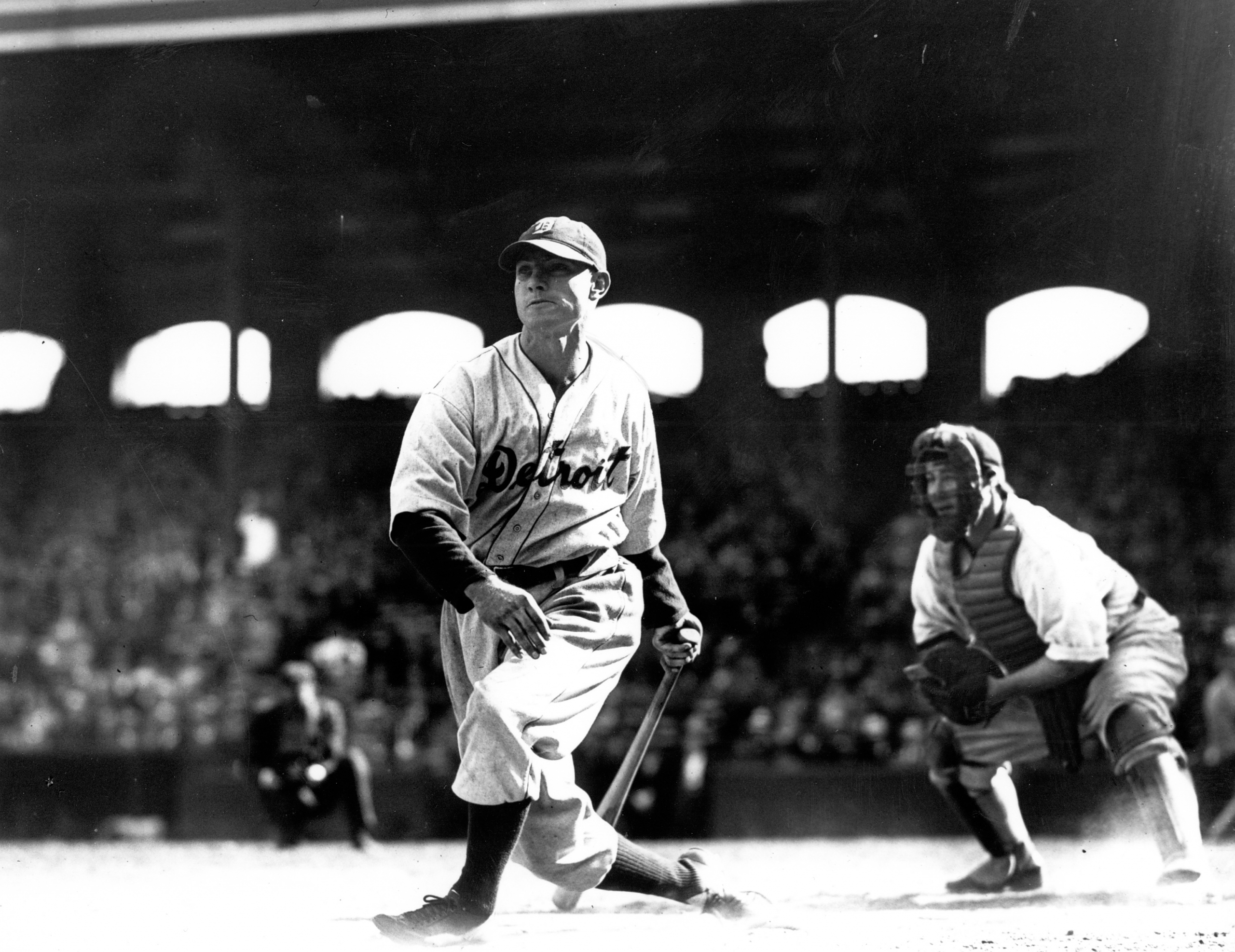 As part of my rigorous and systematic examination of the runs-scored statistics in the official DBD records for Detroit Tigers players for 1920–44, I discovered and corrected 57 errors affecting 37 players. Significantly, the Elias Sports Bureau, pursuant to its review of the relevant supporting documentation I provided to them, eventually approved each runs-scored correction. Thus, this article serves as the formal public disclosure of the authorized corrections/changes in the official runs-scored records—single-season and career—for these 37 players, including four Hall of Famers (Ty Cobb, Heinie Manush, Charlie Gehringer, and Hank Greenberg), for their Detroit Tigers careers. Accordingly, the appropriate corrections/changes can now be legitimately made in the various baseball encyclopedias, record books, information guides, and Web sites.
As part of my rigorous and systematic examination of the runs-scored statistics in the official DBD records for Detroit Tigers players for 1920–44, I discovered and corrected 57 errors affecting 37 players. Significantly, the Elias Sports Bureau, pursuant to its review of the relevant supporting documentation I provided to them, eventually approved each runs-scored correction. Thus, this article serves as the formal public disclosure of the authorized corrections/changes in the official runs-scored records—single-season and career—for these 37 players, including four Hall of Famers (Ty Cobb, Heinie Manush, Charlie Gehringer, and Hank Greenberg), for their Detroit Tigers careers. Accordingly, the appropriate corrections/changes can now be legitimately made in the various baseball encyclopedias, record books, information guides, and Web sites.
While the single-season corrections/changes for runs-scored stats can be implemented for those 37 players for their seasons with the Detroit Tigers, they should not, I feel, be incorporated into their career runs-scored stats if the player also played for any other team(s)—unless the accuracy of the runs-scored stats in the relevant official DBD records has been verified.
From the results reported here for the Detroit Tigers, it is not unreasonable to presume analogous numbers of runs-scored errors for the players on the other major league clubs, particularly the other teams in the American League (for whom the Howe News Bureau was official statistician through 1972). Accordingly, my hope/recommendation is that others also pursue similar run-scored research efforts for their favorite teams.
ACKNOWLEDGMENTS
With gratitude, I thank the following individuals for their contributions in helping me carry out the research described in this article: Ron Antonucci, Steve Boren, Keith Carlson, Mike Lynch, Bob McConnell, and Dixie Tourangeau for providing photocopies of game accounts in newspapers to which they had access; Freddy Berowski, Trent McCotter, Dave Smith, Gary Stone, and Tim Wiles for their cooperation in my efforts to review the pertinent official DBD records; and Seymour Siwoff and Steve Hirdt (Elias Sports Bureau) for their cooperation in reviewing the documentation needed to effect the corrections in the runs-scored errors in the official DBD records.
HERM KRABBENHOFT, a SABR member since 1981, has documented—via official scorecards or game-action newspaper photos—the uniform number(s) of every Detroit Tigers player, manager, and coach for each season from 1931 forward except Frank Doljack (1932), Luke Hamlin (1933), and Roxie Lawson (1933). He is seeking a photocopy of an official Detroit Tigers scorecard from May 1, 1945 or May 2, 1945 (against the White Sox) in order to learn the uniform number of Dutch Meyer, a “phantom” Tiger that season.


